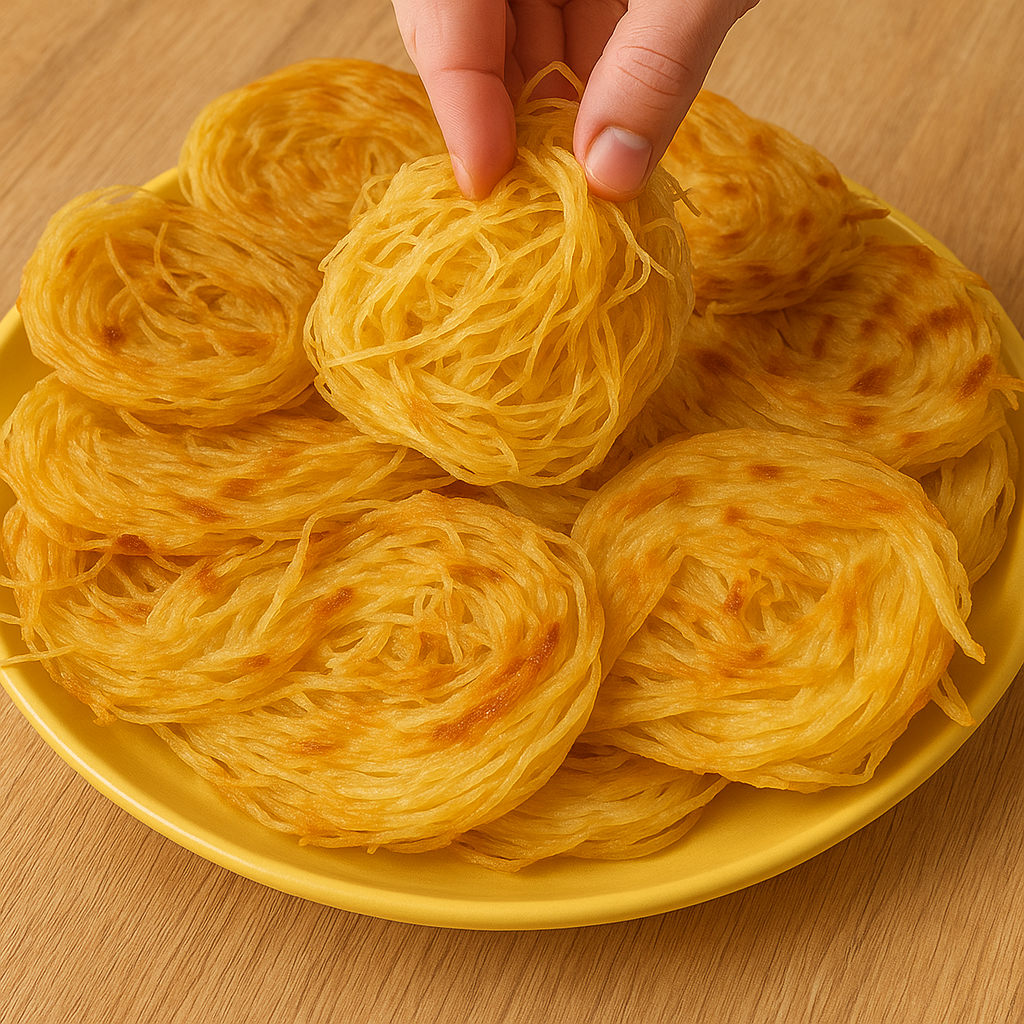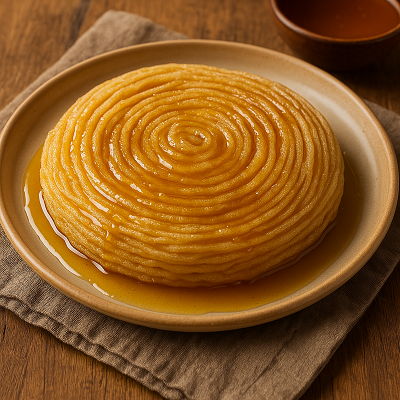
Nest-shaped flatbread
What is Rziza (Rziza el Qadi)?
Coiledbread, also known as Rziza el Qadi, may be a sensitive and outwardly striking Maghrebi cake made after finely coiled homes or spirals of thread-like batter. This dish requires tolerance, aptitude, plus attention despite its fundamental fixings. Customarily delighted in as a breakfast treat or served with rich meat-based sauces, Coiledbread speaks to this culinary artfulness of Maghrebi domestic cooking. Its title, which generally translates to the Turban, highlights its superb status and perplexing, crown-like appearance.Nest-shaped flatbread
Thank you for reading this post, don't forget to subscribe!Presentation: A Bequest of Moroccan Culinary Craftsmanship
Established in a wealthy gastronomic legacy, Coiledbread is more than fair a conventional bread, confirming social class and manual ability. Regularly arranged on extraordinary events or advertised to honored visitors, Nest-shaped flatbreadCoiledbread epitomizes celebration, pride, plus culinary authority passed down through eras. Its shape, surface, plus flavor tell a story of convention, exertion, and adoration from the Maghrebi kitchen.
Even though it might take after other Maghrebi flatbreads,Coiledbread separates itself with its fastidious layering and coiling, coming about in a firm outside plus any delicate, stretchy insides. Sweet with nectar and butter or savory, near tagines and broths.
Benefits of Coiledbread (When Eaten in Balance)
Even though liberal, Coiledbread does provide nutritional esteem:
Wealthy in carbohydrates: Offers fast plus enduring energy, perfect for breakfast.
Boosts satiety: Much appreciated for its thick batter, it can offer assistance to keep you full.
Customizable: Entire wheat flour can extend fiber substance.Nest-shaped flatbread
Solid fat potential: Using olive rather than vegetable oil boosts heart wellbeing.
Tip: make it more beneficial by utilizing entire grain flour and substituting a portion of the oil with more advantageous fats like additional virgin olive oil.
Fixings for Making Coiledbread
Fixing Amount
All-purpose flour 500 grams
Salt ½ teaspoon
Tepid water, as required
Vegetable oil for forming and lubricating
Cornstarch (discretionary) Light tidying
Discretionary increases: A spoonful of semolina or the entirety of wheat flour for the included surface plus dietary esteem.
Step-by-Step Planning Direct
1. Planning the Batter
Blend the flourplus salt in a vast bowl.
Continuously include tepid water while working until you accomplish a smooth, flexible batter.
Manipulate for 10–15 minutes for the best surface.
2. Resting the Batter
Isolate the mixture into little balls.
Coat each one with oil plus cover with plastic wrap or a cloth.
Let them rest for at least 15–20 minutes.
3. Rolling and Forming
Extend each ball of mixture on an oiled surface as thinly as possible until nearly transparent.
Brush with oil delicately once more along with sprinkle a small amount of cornstarch on the off chance that it is needed.
Cut into long strips and roll them into spirals (like coiled homes).
Let them rest once more briefly to hold shape.
4. Cooking the Rziza
Warm a level non-stick skillet or conventional tajine.
Put one Coiledbread winding at a time, tenderly straightening it.
Cook over medium heat until brilliant brown along with fresh on both sides.
How to Serve Coiledbread
Coiledbread is fantastically flexible. Serve it:
Sweet: Sprinkled with warm nectar along with liquefied butter for a conventional breakfast or nibble.
Savory: Combined with sheep or chicken tagine and broth.
Basic: With olive oil and a sprinkle of thyme or cumin.
To serve, it rolled, collapsed, or cut into wedges depending on your fashion.
Brilliant Tip for Culminate Coiledbread
To accomplish that signature thin-thread, continuously let
batter rest long enough. Oil your surface well, and extend the mixture calmly. The more slender it is, such more fragile and flaky your Coiledbread will be.
As often as possible, Inquired Questions
1. Can I utilize the entirety of wheat flour rather than white flour?
Yes, but the surface will be somewhat more provincial and less flexible. Blending both flours can help you adjust.
2. Is Coiledbread gluten-free?
No, made from wheat flour. In any case, what will come about will be different.
3. Can I solidify Coiledbread?
Yes. Solidify the formed (raw) spirals on a plate, and then store in a cooler sack. Cook straight from solidified.
4. How long does Coiledbread remain new?
It is best enjoyed new, but you can keep it in the fridge for up to 3 days and warm it on a dry skillet.
5. Can I bake Coiledbread rather than cooking it in a dish?
Whereas customarily pan-cooked, prepare it in a preheated broiler at 180°C (350°F) until brilliant, but the surface will shift somewhat.
Strong Closing Explanations
Coiledbread is more than a recipe; a consumable piece of Moroccan legacy. With a small honing, ace the rich twirl and idealize the surface. Whether serving it for a family breakfast or a rich supper with visitors, Rziza never fails to inspire.
Rediscover the charm of conventional Maghrebi cuisine, one brilliant winding at
time.
If you’re energetic about genuine nourishment made by hand, Coiledbread is your welcome place to moderate down and savor craftsmanship on one plate.



